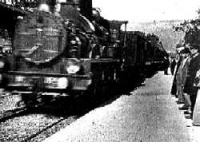Movement
From The Art and Popular Culture Encyclopedia
(Difference between revisions)
| Revision as of 22:35, 18 November 2013 Jahsonic (Talk | contribs) ← Previous diff |
Revision as of 07:59, 19 November 2013 Jahsonic (Talk | contribs) Next diff → |
||
| Line 1: | Line 1: | ||
| [[Image:Arrival of a Train at La Ciotat, 1895.jpg|thumb|left|200px|''[[The Arrival of a Train at La Ciotat Station]]'']] | [[Image:Arrival of a Train at La Ciotat, 1895.jpg|thumb|left|200px|''[[The Arrival of a Train at La Ciotat Station]]'']] | ||
| - | |||
| [[Image:Train wreck at Montparnasse 1895.jpg|thumb|right|200px|''[[Train wreck at Montparnasse]]'' ([[October 22]], [[1895]]) by Studio Lévy and Sons]] | [[Image:Train wreck at Montparnasse 1895.jpg|thumb|right|200px|''[[Train wreck at Montparnasse]]'' ([[October 22]], [[1895]]) by Studio Lévy and Sons]] | ||
| + | [[Image:Wanderer.jpg|thumb|200px|''[[Wanderer above the Sea of Fog]]'' ([[1818]]) by [[Caspar David Friedrich]]]] | ||
| {{Template}} | {{Template}} | ||
| Movement and motion refer to: | Movement and motion refer to: | ||
Revision as of 07:59, 19 November 2013
|
Related e |
|
Featured: |
Movement and motion refer to:
- A state of progression from one place to another.
- A change of position with respect to time.
- A change from one place to another.
Etymology
From Old French movement (modern French mouvement), from Medieval Latin movimentum, from Latin movere (“move”). From Proto-Indo-European *mew- (“to move”).
See also
Unless indicated otherwise, the text in this article is either based on Wikipedia article "Movement" or another language Wikipedia page thereof used under the terms of the GNU Free Documentation License; or on research by Jahsonic and friends. See Art and Popular Culture's copyright notice.




